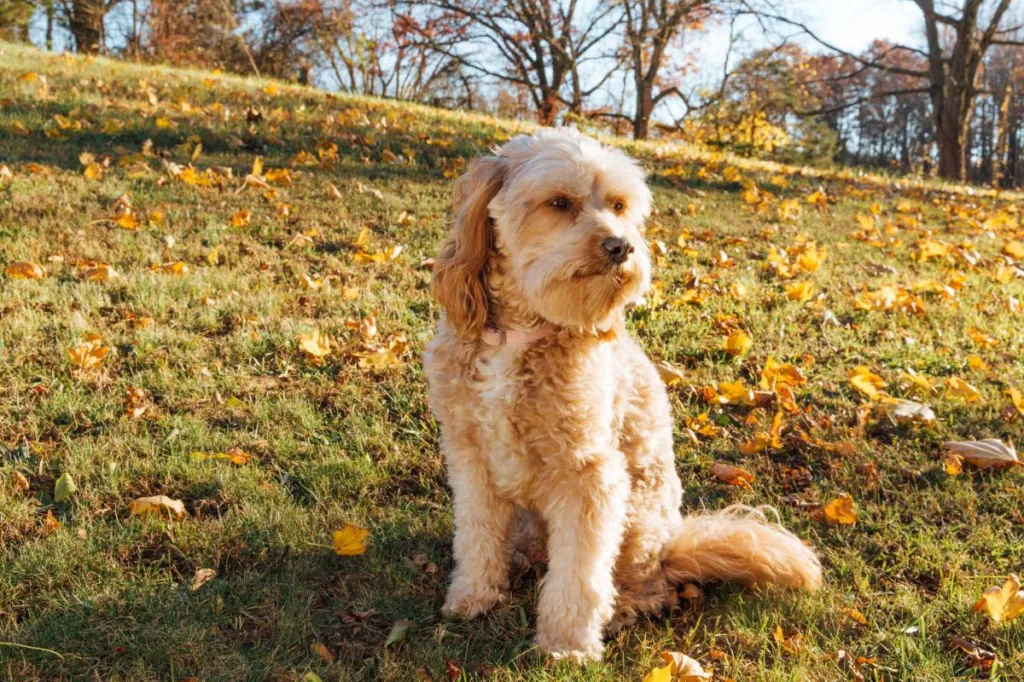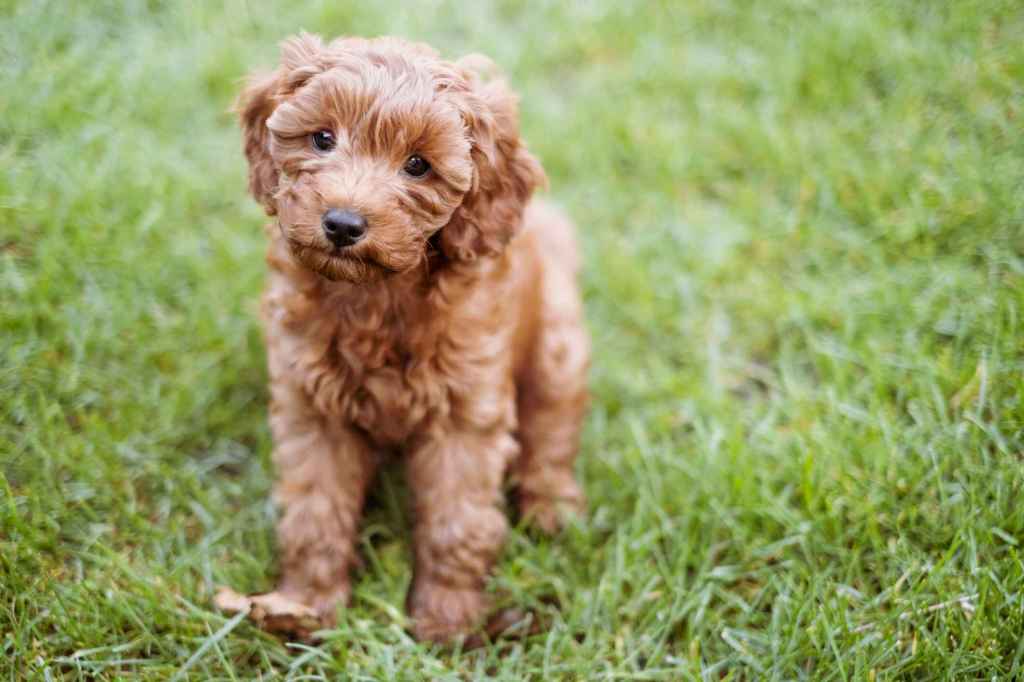The Cavapoo, also known as the Cavoodle, is a small-to-medium-sized hybrid breed, a cross between a Cavalier King Charles Spaniel and a Poodle. These dogs are also known by several names, including Cavadoodle and Cavapoodle. Outgoing, playful, and curious, Cavapoos inherit some of the best traits from their parent breeds. Like many other designer dog breeds, the exact origins and development timeline of the Cavapoo are not well-documented. However, they have quickly become popular in the designer dog world, particularly within the “Doodle dog” category.
With their compact size, unique coloring, and hypoallergenic coat, Cavapoos often resemble teddy bears. Their sweet temperament complements their charming appearance. Known for being sociable, playful, and loving, Cavapoos make excellent family pets thanks to their compatibility with children and outgoing nature. However, without proper training, they can develop destructive habits, such as chewing furniture or shoes and rummaging through trash when left alone.
Cavapoos are friendly with almost everyone and may even greet an intruder with a wagging tail. If you’re looking for a guard dog, this breed is not the best choice. Cavapoos thrive in homes where they receive plenty of attention, whether in a family setting or with an individual owner. While they can adapt to being the only pet in a household, they tend to do best in a “pack” environment.
Cavapoo characteristics
- Height: 9 to 14 inches tall at the shoulder
- Weight: 9 to 25 pounds
- Lifespan: 12 to 15 years
Coat and color variations
The Cavapoo’s coat is typically soft, wavy, or curly, low-shedding, and hypoallergenic, making this breed a popular choice for allergy-prone owners. The texture and curliness of their coat often depend on the specific influence of the Poodle parent. Cavapoos come in a wide range of colors, including solid shades like white, apricot, and black, as well as multicolored patterns like tricolor, parti-color, or merle. Some may have markings that create unique and eye-catching combinations, such as white patches on a darker base or a blend of caramel and cream. Regular grooming is essential to keep their coat in good condition and prevent matting.
Physical traits and appearance
Size and build
- Size: Small to medium; typically 9–14 inches in height and 8–25 pounds in weight.
- Build: Compact and well-proportioned, with a sturdy yet lightweight frame.
Coat colors and texture
- Coat: Soft, wavy, or curly; low-shedding and hypoallergenic.
- Colors: Wide variety, including white, black, apricot, caramel, tricolor, parti-color, and merle.
Facial features
- Face: Rounded with a short to medium-length muzzle.
- Eyes: Large, dark, and expressive, often giving a “puppy-dog” look.
- Ears: Long and floppy.
- Muzzle: Short to medium in length, blending the refined Cavalier and structured Poodle traits.
Other attributes
- Tail: Typically medium-length, carried high.
- Muzzle: Short to medium in length, blending the refined Cavalier and structured Poodle traits.
- Body Shape: Slightly elongated with a balanced and athletic posture.

How big does a Cavapoo get?
The size of a Cavapoo depends largely on the size of their Poodle parent, as Poodles come in three main varieties: Toy, Miniature, and Standard. Cavapoos are most commonly bred with Toy or Miniature Poodles, as Standard Poodles result in significantly larger dogs. Here’s a breakdown of Cavapoo sizes based on the Poodle parent:
Cavapoo size variations
Toy Cavapoo
- Poodle Parent: Toy Poodle
- Height: 9–12 inches at the shoulder | Weight: 8–15 pounds
Mini Cavapoo
- Poodle Parent: Miniature Poodle
- Height: 12–14 inches at the shoulder | Weight: 15–25 pounds
Standard Cavapoo (less common)
- Poodle Parent: Standard Poodle
- Height: 15–18 inches or more at the shoulder | Weight: 25–40 pounds
Cavapoo temperament
Cavapoos have become popular because they have such an amicable and winning personality. They’re a popular family dog, thanks to their outgoing, playful, and affectionate temperament. That said, the Cavapoo is not a dog that tolerates being alone very much, and they could experience separation anxiety if not properly socialized and trained. The Cavapoo is an intelligent breed and lives for your validation and praise.
This makes Cavapoos easy to train, as they are eager to please. Cavapoos can be athletic, too, making them great in agility and obedience competitions. As they can be somewhat attached to the hip, it is important to train your Cavapoo early so they know how to be alone.
Without proper training, your Cavapoo could turn to destructive behaviors, like chewing furniture and shoes or rooting through the garbage, when left alone. Cavapoos tend to get along with everyone and may even greet an intruder with a wag of their tail. With that in mind, if you are looking for a guard dog, a Cavapoo isn’t a good choice. Cavapoos tend to thrive most in homes where they get loads of attention, whether with a family or an individual.
Personality and behavior traits
- Friendly: Cavapoos are highly sociable and enjoy interacting with people and other pets.
- Affectionate: They are loving and thrive on companionship, making them excellent lap dogs.
- Playful: Cavapoos have an energetic and fun-loving nature, great for families with children.
- Intelligent: Inheriting smarts from their Poodle parent, they are quick learners and eager to please.
- Adaptable: They adjust well to various living situations, from apartments to larger homes.
- Gentle: Known for their sweet and calm demeanor, they are ideal for households with young children or elderly members.
- Attention-Seeking: They crave interaction and can become clingy if left alone for long periods.
- Alert: While not aggressive, they are observant and will bark to alert owners of unfamiliar sounds or people.
Cavapoo history
The Cavapoo, also known as the Cavoodle, is a relatively modern designer dog breed that originated in the late 20th century. While the exact timeline and location of their development are not well-documented, it’s believed they were first intentionally bred in the United States or Australia during the 1990s. The aim was to combine the affectionate and gentle nature of the Cavalier King Charles Spaniel with the intelligence, hypoallergenic coat, and low-shedding qualities of the Poodle.
Cavapoos quickly gained popularity due to their appealing physical traits, such as their teddy bear-like appearance, and their friendly, adaptable temperaments. Over the years, Cavapoos have become a beloved member of the “Doodle” category of designer breeds, which includes other popular hybrids like Labradoodles and Goldendoodles. Despite their relatively short history, Cavapoos have firmly established themselves as one of the most sought-after designer dogs.

Training and socialization
Early socialization and positive reinforcement training are crucial due to their intelligence and potential stubbornness. Of course, their intelligence and eagerness to please allow them to pick up commands quickly, so early training is key to establishing good behavior from the start. Use praise, treats, and affection to reward desired behavior. Because of their Cavalier King Charles Spaniel heritage, Cavapoos respond extremely well to positive reinforcement. They are sensitive and may not respond well to harshness in the voice. A positive approach will keep them motivated and engaged.
Training tips:
- Be Consistent: Consistency is crucial in training. Use the same commands and routines to avoid confusion. This helps your Cavapoo understand what is expected of them.
- Keep Training Sessions Short and Fun: Cavalier Poodle mixes are intelligent but can lose interest if training sessions are too long or repetitive. Keep sessions short (10-15 minutes) and engage with varied activities.
- Mental Stimulation: Incorporate puzzle toys, obedience training, and interactive games into their routine to challenge their mind. A bored Cavapoo can become restless or depressed. Once basic obedience is established, teach more advanced commands or tricks.
Cavapoo grooming needs and care
As with all dogs, it’s important to keep up your Cavapoo’s regular veterinary checkups to detect any health concerns early. Your vet can help you develop a care routine that will keep your dog healthy.
The Cavalier Poodle mix’s coat comes in an array of colors, patterns, and textures depending on their genetic makeup. Like other Poodle mixes, they don’t typically shed much. Remember that this does not mean they do not cause allergies, only that they’re less likely to do so. Of course, breeds with Poodle-type coats sometimes need additional grooming to avoid matting.
Are Cavapoos hypoallergenic?
Cavapoos are often described as hypoallergenic, but it’s important to understand what this means in the context of dog breeds. While no dog is 100% hypoallergenic, Cavapoos are considered a better choice for allergy-prone individuals because they tend to shed very little, reducing the spread of allergens like dander and hair.
The hypoallergenic quality of a Cavapoo largely depends on the type of coat they inherit:
- Curly coat (like a Poodle): Most hypoallergenic, as it traps dander and hair more effectively, reducing allergens in the environment.
- Wavy coat (mix of Cavalier and Poodle): Moderately hypoallergenic, shedding less than a Cavalier but more than a Poodle.
- Straight coat (like a Cavalier): Least hypoallergenic, as it sheds more and spreads more allergens.

How to groom a Cavapoo
Grooming a Cavapoo is essential to maintain their soft, low-shedding coat and overall health. Their coat type, which can range from wavy to curly, requires consistent care to prevent tangles and matting.
Coat care
Brushing:
- Frequency: Brush your Cavapoo 2-3 times per week to prevent matting and tangles, especially if they have a curly or wavy coat. If their coat leans more toward the Poodle side, you may need to brush daily.
- Tools: Use a slicker brush or pin brush for their curly or wavy coat, and a comb to detangle any knots. Pay extra attention to areas that are prone to matting, like behind the ears, under the legs, and around the collar.
Bathing:
- Frequency: Bathe your Cavapoo every 4-6 weeks or as needed. Frequent baths can dry out their skin, so stick to a gentle dog shampoo.
- Drying: After a bath, towel-dry and use a blow dryer on a low, cool setting if necessary. Make sure their coat is fully dry to prevent any moisture from causing irritation.
Trimming:
- Professional Grooming: If your Cavapoo has a curly or thick coat like a Poodle, consider having them professionally groomed every 6-8 weeks. Groomers can shape the coat, keep it manageable, and trim around sensitive areas like the paws, face, and tail.
- Home Trimming: You can trim their coat at home using dog clippers or scissors for a tidy appearance, especially around the eyes and paws to avoid irritation.
Ear care
- Check for Dirt and Moisture: Cavapoos may be prone to ear infections. Check their ears weekly for signs of dirt, wax buildup, or moisture, which can lead to infections.
- Cleaning: Clean their ears with a veterinary-approved ear cleaner and a cotton ball or pad. Avoid using cotton swabs, as they can push debris further into the ear.
Nail trimming
- Frequency: Trim your Cavapoo’s nails every 4-6 weeks, depending on their activity level. Active dogs may naturally wear down their nails, but indoor or less active dogs will need more frequent trims.
- Tip: Use a dog nail clipper or a grinder. Be careful not to cut too far down, as hitting the quick (the blood vessel inside the nail) can be painful and cause bleeding.
Dental and eye care
- Brush Regularly: Brush your Cavapoo’s teeth 2-3 times per week using a dog-specific toothbrush and toothpaste. Small breeds are more prone to dental problems. Frequent teeth brushing helps prevent plaque buildup.
- Clean Around the Eyes: If your Cavapoo’s coat grows around their eyes, regularly trim the hair to prevent irritation. Use a clean, damp cloth to gently wipe away any eye discharge or tear stains.
Flea, tick, and parasite control
Keep up with flea and tick prevention treatments, especially if your Cavapoo spends much time outdoors. Regular grooming allows you to spot parasites early.
Early acclimation is key
Getting your Cavapoo accustomed to grooming procedures from a young age makes the process easier and more enjoyable for both of you. Handle their paws frequently, examine their mouth and ears, and reward them for good behavior during grooming sessions. This positive foundation sets the stage for stress-free veterinary exams and handling throughout their lives.

Feeding and nutrition
Cavapoos require a well-balanced diet tailored to their size, age, activity level, and overall health. High-quality dog food—whether commercially produced or home-prepared under veterinary guidance—is essential to meet their nutritional needs. Their diet should include the right balance of protein, fats, and carbohydrates, with added vitamins and minerals for optimal health. Cavapoos are prone to obesity, so portion control and limiting treats are important. Puppies, adults, and senior Cavapoos have varying dietary needs, with puppies requiring more frequent meals for growth and seniors benefiting from lower-calorie diets to support healthy aging.
Puppies (2–12 months)
- Meals per Day: 4 meals (reduce to 3 meals after 6 months).
- Portion Size: 1/4 to 3/4 cup of puppy food daily, divided into meals.
- Notes: Choose high-quality puppy food rich in protein and nutrients for healthy growth.
Adults (1–7 years)
- Meals per Day: 2 meals.
- Portion Size by Weight:
- 8–12 lbs: 1/2 to 1 cup of food daily.
- 13–25 lbs: 3/4 to 1 1/2 cups of food daily.
- 25-40 lbs: 1 3/4 to 2 1/2 cups of dry food per day.
- Notes: Select a balanced adult dog food that supports their energy levels and maintains a healthy weight.
Seniors (7+ years)
- Meals per Day: 2 smaller meals.
- Portion Size: Similar to adults, but adjust based on reduced activity.
- Notes: Consider senior-specific formulas to support digestion, joint health, and lower calorie needs.
Cavapoo family compatibility
Cavapoos make a wonderful choice for families due to their affectionate temperament, outgoing personalities, and propensity to form strong bonds with their humans. Their playful and gentle nature suits them as a perfect companion for children, while their small size makes them suitable for homes or apartments with limited space. Cavapoos are also known to get along with other pets, including cats and other small animals, as long as they’re properly socialized. This devoted breed thrives on human interaction, which can often mean they are happier with families where there is always a guaranteed human to keep them company. Their moderate energy levels ensure they can enjoy active playtime but also appreciate calm, cuddly moments. Cavapoos can be prone to separation anxiety if left alone for long periods.

Cavapoo health issues
Cavapoos are generally healthy dogs, but like all breeds, they can inherit or develop certain health problems. Many of these conditions are influenced by their parent breeds (Cavalier King Charles Spaniel and Poodle). Regular vet check-ups and a healthy lifestyle can help minimize risks. Below are some common health issues in Cavapoos:
- Mitral Valve Disease (MVD): Mitral Valve Disease is a heart condition inherited from the Cavalier King Charles Spaniel parent. It causes the mitral valve in the heart to deteriorate, leading to heart murmurs or failure. Symptoms include fatigue, coughing, and difficulty breathing. Regular cardiac screenings, especially in older dogs, can help manage the condition.
- Hip Dysplasia: Hip Dysplasia occurs when the hip joint doesn’t develop properly, leading to pain and arthritis. Symptoms may include limping, difficulty rising, or reluctance to exercise. Preventing obesity and avoiding high-impact activities can help reduce the risk.
- Patellar Luxation: Patellar Luxation is a condition where the kneecap slips out of place, which is common in small breeds. Symptoms may include intermittent limping or skipping steps. Veterinary care can help address the condition if needed.
- Progressive Retinal Atrophy (PRA): Progressive Retinal Atrophy is a degenerative eye condition that leads to vision loss and, eventually, blindness. Symptoms include night blindness and bumping into objects. Genetic testing of breeding parents can help prevent this condition.
- Ear Infections: Cavapoos’ floppy ears can trap moisture, creating a breeding ground for infections. Symptoms include head shaking, redness, or a foul odor. Regular ear cleaning and keeping ears dry can help prevent infections.
- Allergies: Cavapoos may develop food or environmental allergies, which can cause skin irritation or digestive issues. Symptoms include itchy skin, ear infections, vomiting, or diarrhea. Identifying and avoiding allergens, as well as consulting a vet, can help manage allergies.
- Dental Issues: Small dogs like Cavapoos are prone to tartar buildup and periodontal disease. Symptoms include bad breath, gum inflammation, or tooth loss. Regular brushing and dental check-ups are essential to maintain oral health.
- Addison’s Disease: Addison’s Disease is a condition where the adrenal glands fail to produce sufficient hormones, which can be inherited from Poodles. Symptoms include lethargy, vomiting, and loss of appetite. Early diagnosis and ongoing veterinary care are critical for managing this condition.
Rescue groups and shelters
If you’re looking for Cavapoo puppies, it’s always worth starting with rescues. Despite their designer status, many may still end up in rescue organizations. Of course, it may be hard to find a breed-specific rescue for Cavapoos because they are a mixed breed. However, you may want to try Cavalier King Charles Spaniel or Poodle breed-specific rescues, as they often care for mixes, as well. Here are some rescues you can try:

How much are Cavapoo puppies?
The price of Cavapoo puppies typically ranges between $2,500 and $5,000 when purchased from a reputable breeder. While some breeders may offer Cavapoo puppies at much lower prices, this should be considered a warning sign. Unless the puppy is coming from a verified rescue and is more affordable for that reason, avoid deals that seem too good to be true. Unfortunately, many backyard breeders and puppy mills exploit the popularity of this breed, selling puppies for profit without regard for humane breeding practices. This increases the risk of ending up with a puppy suffering from illnesses or hereditary conditions. If you choose to purchase a Cavapoo puppy, always find a reputable breeder.















